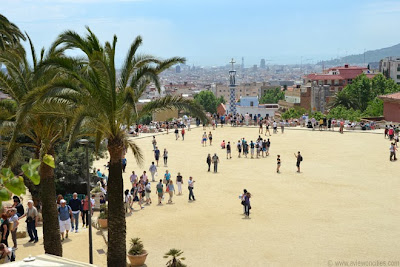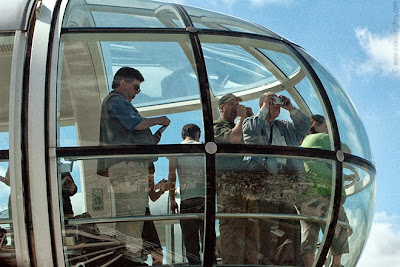The Brooklyn Bridge, built between 1869 and 1883, connects Manhattan
with New York's most populous borough, Brooklyn. The bridge is one of
the most famous and magnificent landmarks in New York City.
At the time of construction, Brooklyn - founded by
Dutch settlers in the 17th century - was still an independent city. In
fact it was even one of the country's largest cities. In 1898, 15 years
after the opening of the Brooklyn Bridge, Brooklyn citizens decided in a
close vote to become a borough of New York.
Construction
Brooklyn Bridge arch
The construction of the Brooklyn Bridge started in 1869 and took 14
years to complete. At the time many saw the construction of such a large
bridge as a folly.
The driving force behind the whole project, John Roebling, was a German immigrant who had worked for the Prussian government as a bridge and road builder. He launched the idea of building a bridge across the East River after he had taken a ferry across the river that ended up stuck in the ice.
John Roebling would never get to see the bridge he had designed: he died after crushing his foot in an accident. He wasn't the only one to lose his life during the construction: 20 of the in total 600 workers died while working on the bridge. The son of John Roebling, Washington Roebling, took over the leadership of the project but he suffered from the caisson-disease as a result of the works on the pillars of the bridge and was on his deathbed during the inauguration. That day, May 24, 1883, about 150,000 people crossed the bridge.
Roebling had not just made a bridge that looked incredibly strong, it also turned out to be just as strong in reality. A mesh of cables of which the four strongest have a diameter of 11 inches (28 cm) are anchored in the ground and keep the bridge from collapsing. But even if the four strongest cables would snap, the other cables would still be sufficient to support the bridge. Roebling even claimed that the bridge wouldn't collapse without any cables, it would merely sag.
But even after the inauguration, many New Yorkers were not convinced the bridge was safe. So as to prove the doubters wrong, P.T. Barnum led a caravan of circus animals - including a herd of 21 elephants - across the bridge in 1884.
The driving force behind the whole project, John Roebling, was a German immigrant who had worked for the Prussian government as a bridge and road builder. He launched the idea of building a bridge across the East River after he had taken a ferry across the river that ended up stuck in the ice.
John Roebling would never get to see the bridge he had designed: he died after crushing his foot in an accident. He wasn't the only one to lose his life during the construction: 20 of the in total 600 workers died while working on the bridge. The son of John Roebling, Washington Roebling, took over the leadership of the project but he suffered from the caisson-disease as a result of the works on the pillars of the bridge and was on his deathbed during the inauguration. That day, May 24, 1883, about 150,000 people crossed the bridge.
Roebling had not just made a bridge that looked incredibly strong, it also turned out to be just as strong in reality. A mesh of cables of which the four strongest have a diameter of 11 inches (28 cm) are anchored in the ground and keep the bridge from collapsing. But even if the four strongest cables would snap, the other cables would still be sufficient to support the bridge. Roebling even claimed that the bridge wouldn't collapse without any cables, it would merely sag.
But even after the inauguration, many New Yorkers were not convinced the bridge was safe. So as to prove the doubters wrong, P.T. Barnum led a caravan of circus animals - including a herd of 21 elephants - across the bridge in 1884.
The Bridge
The Brooklyn Bridge ranks as one of the greatest
engineering feats of the 19th century and remains one of New York's most
popular and well known landmarks.
The impressive bridge spans the East river between Brooklyn and Manhattan and stretches for a length of 5989 ft, about 1.8 km. The span between the large towers measures 1595.5 ft (486 meters). This made the Brooklyn Bridge the world's largest suspension bridge.
The most noticeable feature of the Brooklyn Bridge are the two masonry towers to which the many cables are attached. The towers with large Gothic arches reach a height of 276 ft (84 meters), at the time making them some of the tallest landmarks in New York. Roebling claimed that the monumental towers would make the bridge a historic monument. He was proven right when the bridge officially became a national monument in 1964.
The impressive bridge spans the East river between Brooklyn and Manhattan and stretches for a length of 5989 ft, about 1.8 km. The span between the large towers measures 1595.5 ft (486 meters). This made the Brooklyn Bridge the world's largest suspension bridge.
The most noticeable feature of the Brooklyn Bridge are the two masonry towers to which the many cables are attached. The towers with large Gothic arches reach a height of 276 ft (84 meters), at the time making them some of the tallest landmarks in New York. Roebling claimed that the monumental towers would make the bridge a historic monument. He was proven right when the bridge officially became a national monument in 1964.
Footpath
An elevated pedestrian path not only gives you the opportunity to cross
the river without being bothered by the traffic that rushes past a level
below, but it also offers a great view of the bridge's towers as well
as downtown Manhattan's skyline. The views alone attract millions of
visitors to this bridge each year.






































